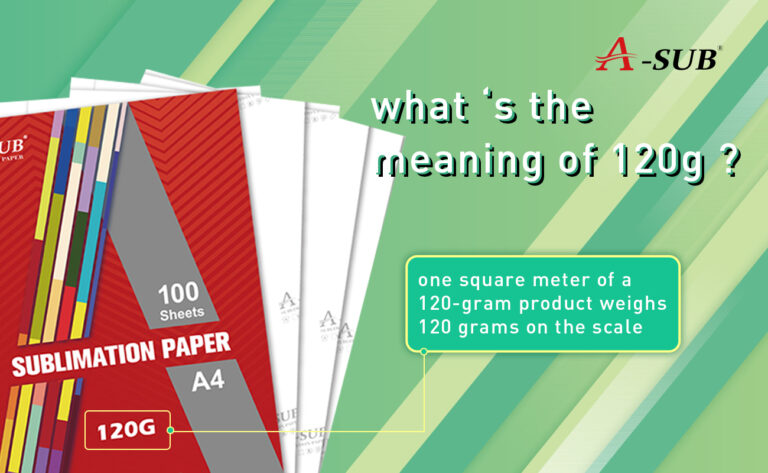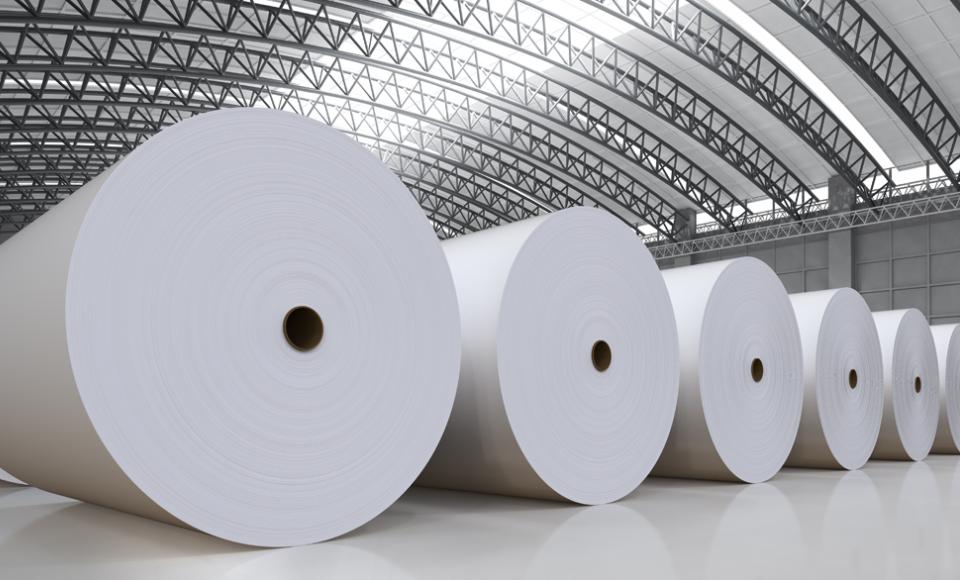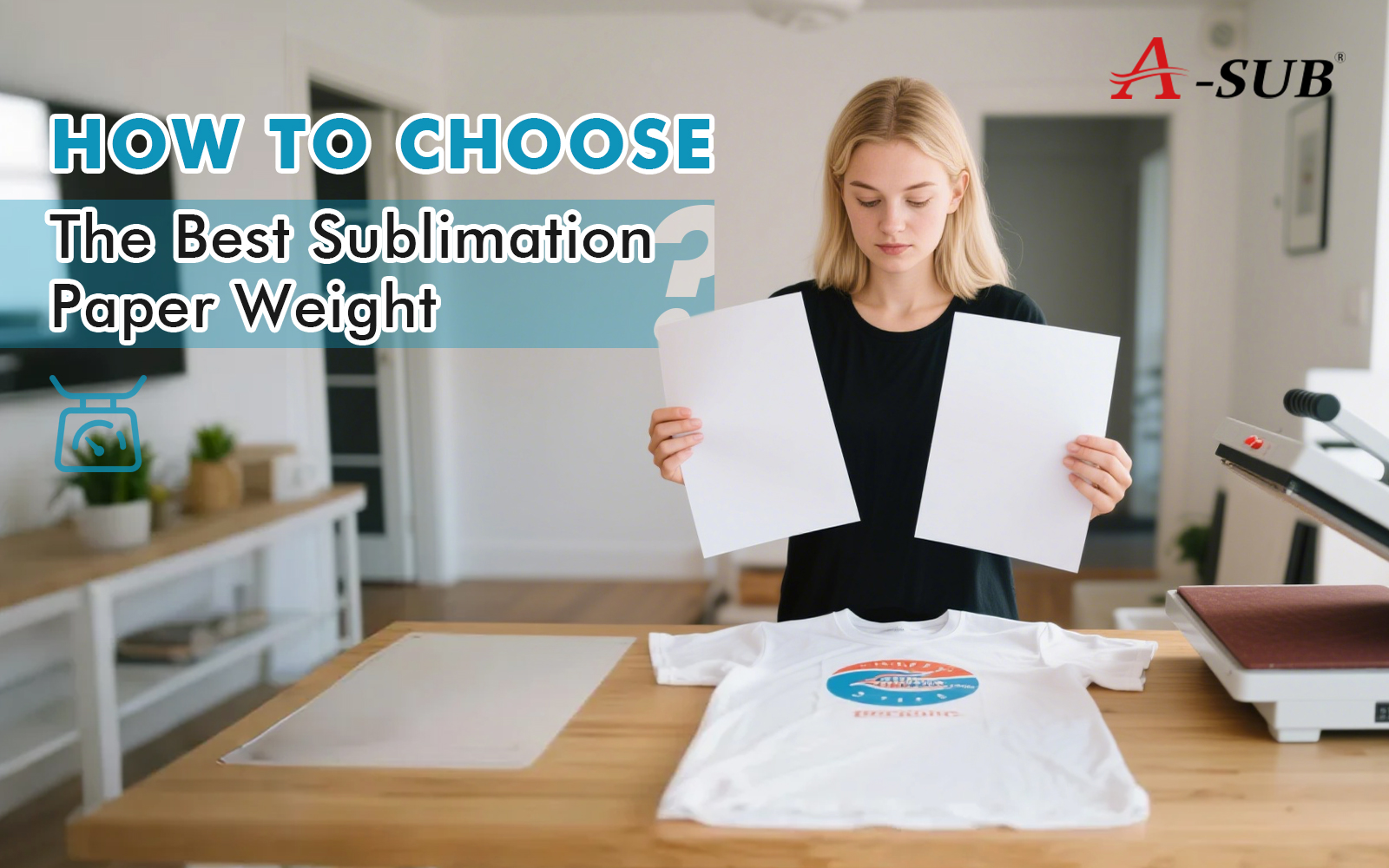Have you ever encountered the following troubles?
The color of the carefully designed T-shirt pattern is grey after transferring, and the red color that should be saturated looks pale and weak? Or when transferring a ceramic mug, the pattern breaks and fails to fit the curved surface, resulting in a significant loss of overall texture?
Replace the ink, adjust the settings, or even redesign the pattern, only to find that nothing helps. In fact, the problem may lie in a detail that is often overlooked or poorly understood – sublimation paper weight.
Now, A-SUB will bring you an expert’s perspective to understand the grammage difference of sublimation paper and help you make a wise choice.
What Is the Paper Weight in Sublimation Paper?

Grammage (gsm), the grammage of paper per square meter, is a central indicator of paper thickness and density.
-
Relationship between gsm and thickness, ink absorption capacity: Generally, the higher the gsm, the thicker the paper and the greater the ink carrying capacity. However, this can also mean slower drying or an increased risk of curling.
-
GSM ≠ Quality: Don’t fall into the trap of thinking heavier always means better. What really matters is how well the paper’s coating, fiber structure, and sublimation compatibility are engineered.
-
GSM = Compatibility: The best GSM for you depends on more than just numbers. It needs to match your printer type, the complexity of your designs, your transfer surface, and your overall workflow.
Application Scenarios for Different Paper Weights
In discussing this issue, let’s think about it in a different way:
what kind of print results do I need to achieve?
Pursuing ‘Speed, Lightness, and Efficient Output’ – Ultra-Light Gram Weight Paper (29g–33g)
If you run an apparel processing factory handling thousands of T-shirts, sportswear, or home textile orders daily, speed and stability are undoubtedly your top priorities. In such scenarios, 29g and 33g ultra-light gram weight sublimation paper rolls are your ideal partners.
Specifically designed by A-SUB® for roll-to-roll high-speed printers, these two types of sublimation paper offer exceptional flexibility and smoothness, supporting continuous output, rapid drying, and resistance to paper jams or warping – perfect for industrial-scale large-format production. Their low gram weight design reduces the pressure of paper tension on equipment while also saving ink, helping you maintain transfer quality while controlling costs. Although they slightly lag behind higher gram weight papers in image quality reproduction, they still deliver stable performance within standard color ranges.
In specific applications, the A-SUB® 33g Jumbo Roll is widely used in high-volume T-shirt and home textile transfers, becoming a mass-production workhorse for many factories due to its stability and continuous output capabilities.
When the production line needs “print-and-transfer-immediately” to meet extreme capacity challenges, the A-SUB® 29g, with its lighter paper structure, demonstrates superior adaptability and speed advantages.
Suitable Projects: Fast-fashion apparel, large-format fabrics, sportswear, curtains, shower curtains, industrial-grade roll-to-roll transfers.

Balancing ‘Image Quality and Efficiency’ – Medium Gram Weight Paper (105g–120g)
Your designs aren’t so complex that they require ultra-high precision, but you also don’t want to compromise on color reproduction. For example, if you’re creating illustrated-style canvas bags, customized shoe uppers, or personalized gifts with rich color layers and moderate detail requirements, medium gram weight paper is the perfect choice.
The A-SUB® 105g and 120g sublimation papers strike a precise balance between ink absorption capacity and flatness. They won’t suffer from ink bleeding and blurring due to too low a gram weight, nor will they slow down equipment like higher gram weight papers. Especially in small-to-medium batch, diversified pattern printing tasks, these papers are both stable and worry-free.
Suitable Projects: Personalized gifts, illustrated canvas bags, small-batch clothing, DIY projects, multi-color light/dark pattern combination transfers.
Prioritizing Ultimate Image Quality and Complex Pattern Printing – Heavy Gram Weight Paper (125g)
High-weight sublimation paper is favored by DIY bloggers, and it’s not for nothing. High-weight sublimation paper has a few advantages that low and medium weight papers can’t match.
First, it offers greater ink absorption and better control of color saturation. Complex patterns often have richer textures and color variations, and higher-weight papers have thicker coatings and a denser fiber structure that locks in the ink securely, preventing smudging and ensuring a crisp image with reproducible detail.
Additionally, high-gram-weight paper demonstrates greater stability under harsh conditions like multi-layer printing and high-temperature pressing, making it particularly suitable for hard materials with flat or slightly curved surfaces, such as metal prints and wooden plaques. It’s important to note that for objects with high curvature (e.g., ceramic mugs), lighter gram weight paper with better flexibility is recommended to avoid poor adhesion or pattern cracking due to excessive rigidity.
We recommend A-SUB® 125g Sublimation Paper to you. Proud to say that our brand has gained popularity and reputation in the sublimation paper industry. Whether you search “best sublimation paper” on Google or “sublimation paper” on Amazon, our products appear on the first page and are repeatedly recommended by many DIY bloggers.
Suitable Projects: Art reproduction, high-end photography output, metal prints, wooden decorations, customized hard gifts.
Other Factors Influencing Gram Weight Selection
Choosing the right gram weight involves not only the application scenario but also practical operating conditions:
Printer Compatibility: Some printers can’t handle very thick paper.
Printer compatibility: Some devices have maximum gram weight restrictions, especially roll-to-roll high-speed machines.
Handling method differences: Automatic feeding requires high paper flatness, thick paper is prone to jams.
Ink brand/formula variations: Some inks have strong penetrability and require higher gram weight paper to control back bleeding.
Humidity and drying speed: In humid environments, fast-drying high-gram-weight paper is more stable.
Common Questions and Adjustment Tips for Gram Weight Selection (FAQ & Tips)
Here’s a quick reference for common issues and what to change:
|
Common Issue
|
Possible Cause
|
Recommended Adjustment
|
|
Colors look faded
|
Low ink absorption, too much bleed
|
Use heavier paper (e.g., 105g → 120g)
|
|
Paper curls or lifts
|
Paper too light, high humidity
|
Use heavier or higher flatness paper
|
|
Ink bleeding or ghosting
|
Thin coating, low weight
|
Use anti-bleed, higher weight paper
|
|
Roller marks
|
Paper too thick or slow drying
|
Try lighter or faster-drying models
|
|
Blurry or double edges
|
Ink too wet, poor absorption, or too thick
|
Use quick-dry or lighter paper
|
|
White spots on curves
|
Paper too stiff for tight fit
|
Use 33g soft paper + heat shaping
|
Reminder: For high-curvature transfers (e.g., ceramic mugs, spheres), thicker paper may cause “orange peel” texture or poor adhesion due to high rigidity. It is recommended to use light paper with low-temperature hot air treatment.
Why Choose A-SUB® Sublimation Paper?
A-SUB® always insists on driving product upgrades through technological innovation:
Multi-layer micro-porous coating technology: Effectively locks ink and prevents smudging
Fast-drying and anti-bleeding: Improves production efficiency and reduces defect rates
Leading global sales and reputation: Serves 50+ countries and wins praise from millions of users
Complete product range: Covers light, medium, and heavy gram weights to meet all sublimation needs
Conclusion
Sublimation printing is a systematic project highly dependent on the coordination of materials, paper weight is directly related to the ink adsorption, image reproduction, transfer fit and so on.
Choosing the wrong grammage will not only affect the aesthetics of the finished DIY products, but may also lead to the scrapping of the whole batch of products for enterprises.
This is not a “one-size-fits-all” decision, but requires dynamic and flexible adjustments.
Project Type + Ink Type + Color Depth + Printer Settings = Best Paper Weight
Whether you’re an industrial giant or a personalized studio, A-SUB® offers the ideal gram weight sublimation paper for your needs. Choose A-SUB® to ensure every sheet of sublimation paper is used to its full potential.
For samples or more product information, welcome to contact us. If you’re unsure about the right gram weight for your needs, please leave a message with your specific application, and we’ll recommend the best fit for you.


发表回复